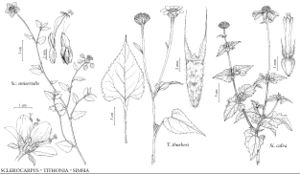Tithonia
Gen. Pl., 189. 1789.
| Taxon | Illustrator ⠉ | |
|---|---|---|
 | Sclerocarpus uniserialis Tithonia thurberi Simsia calva | Linny Heagy Yevonn Wilson-Ramsey Yevonn Wilson-Ramsey |
Annuals, perennials, subshrubs, or shrubs [trees], 70–500 [–700] cm. Stems erect, branched. Leaves all or mostly cauline; opposite (proximal) or mostly alternate; petiolate or sessile; blades often (1-), 3-nerved, or 5-nerved, mostly deltate or pentagonal [lanceolate, linear], sometimes 3-lobed or 5-lobed, bases ± truncate or auriculate [attenuate] (sometimes decurrent onto petioles), ultimate margins serrate to crenate, faces glabrate, ± hirsute, pilose, soft-pubescent, or villous, often glanddotted. Heads borne singly (peduncles usually distally dilated, fistulose). Involucres campanulate to hemispheric, 10–20+ mm diam. Phyllaries persistent, 12–28+ in 2–5 series (linear to broadly rounded, unequal to subequal, apices acute to rounded). Receptacles hemispheric to convex, paleate (paleae persistent, embracing cypselae, striate, ± 3-toothed, middle teeth larger, stiff, acute or acuminate to aristate). Ray-florets 8–30, neuter; corollas yellow or orange. Disc-florets 40–120 [–200+], bisexual, fertile; corollas yellow, tubes shorter than throats (bases of throats bulbous and hairy), lobes 5, ± triangular (anthers black, brown, or tan, bases cordate-sagittate, appendages ovate; style-branches relatively slender, appendages penicillate or lanceolate to attenuate). Cypselae (black or brown) ± compressed or flattened, often 3-angled or 4-angled or biconvex, ± cuneiform in silhouette (sometimes with basal elaiosomes); pappi 0, or ± coroniform (of ± connate scales, 1–2 scales sometimes subulate to aristate). x = 17.
Distribution
sw United States, Mexico, Central America, in se United States, West Indies, South America, and Old World
Discussion
Species 11 (3 in the flora).
Selected References
Lower Taxa
Key
| 1 | Perennials, subshrubs, or shrubs; phyllaries 16–28; ray laminae 48–69 mm; disc florets 80–120+; cypselae 4–6 mm | Tithonia diversifolia |
| 1 | Annuals; phyllaries 12–16; ray laminae 9–15 or 20–33 mm; disc florets 40–60 or 60–90; cypselae 5–9 mm | > 2 |
| 2 | Leaf blades ± deltate to pentagonal, often 3- or 5-lobed, abaxial faces soft-pubescent; rays usually orange, rarely yellow, laminae 20–33 × 6–17 mm | Tithonia rotundifolia |
| 2 | Leaf blades mostly deltate, rarely, if ever, lobed, abaxial faces sparsely hirsute (hairs larger on veins); rays yellow, laminae 9–15 × 4–6 mm | Tithonia thurberi |